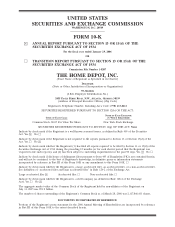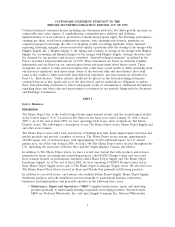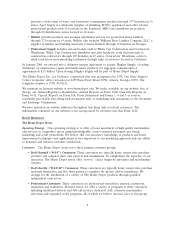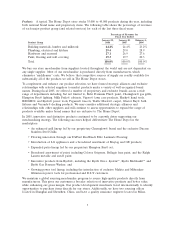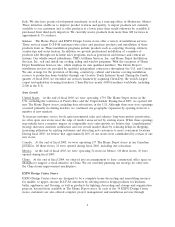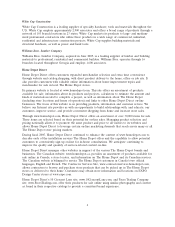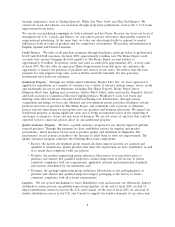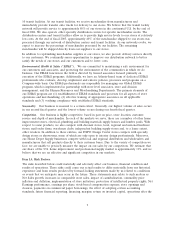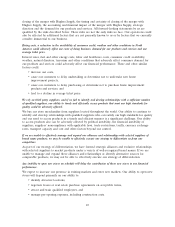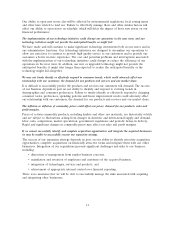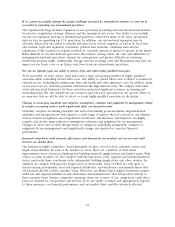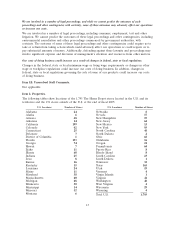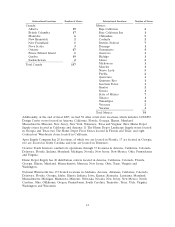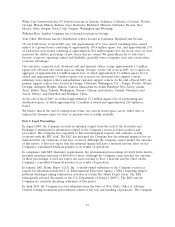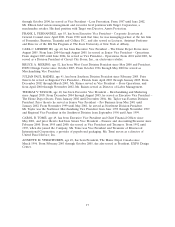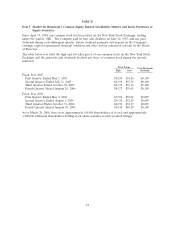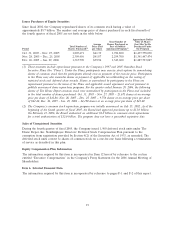Home Depot 2005 Annual Report Download - page 21
Download and view the complete annual report
Please find page 21 of the 2005 Home Depot annual report below. You can navigate through the pages in the report by either clicking on the pages listed below, or by using the keyword search tool below to find specific information within the annual report.10 transit facilities. At our transit facilities, we receive merchandise from manufacturers and
immediately provide transfer onto trucks for delivery to our stores. We believe that the transit facility
network will provide service to approximately 80% of our stores in the continental U.S. by the end of
fiscal 2006. We also operate other specialty distribution centers for specific merchandise needs. The
distribution centers and transit facilities allow us to provide high service levels to our stores at relatively
low costs. At the end of fiscal 2005, approximately 40% of the merchandise shipped to our stores was
processed through our network of distribution centers and transit facilities. As our networks evolve, we
expect to increase the percentage of merchandise processed by our facilities. The remaining
merchandise will be shipped directly from our suppliers to our stores.
In addition to replenishing merchandise supplies at our stores, we also provide delivery services directly
to our customers. We continually assess opportunities to improve our distribution network to better
satisfy the needs of our stores and our customers and to lower costs.
Environmental, Health & Safety (‘‘EH&S’’). We are committed to maintaining a safe environment for
our customers and associates, and protecting the environment of the communities in which we do
business. Our EH&S function in the field is directed by trained associates focused primarily on
execution of the EH&S programs. Additionally, we have an Atlanta-based team of dedicated EH&S
professionals who evaluate, develop, implement and enforce policies, processes and programs on a
Company-wide basis. Our EH&S professionals are responsible for managing our Global EH&S
program, which is implemented in partnership with store level associates, store and division
management, and the Human Resources and Merchandising Departments. The primary elements of
our EH&S program are (1) establishment of EH&S standards and processes for all aspects of store
operations and merchandising, (2) effective training of appropriate associates on all applicable
standards and (3) verifying compliance with established EH&S standards.
Seasonality. Our business is seasonal to a certain extent. Generally, our highest volume of sales occurs
in our second fiscal quarter and the lowest volume occurs during our fourth fiscal quarter.
Competition. Our business is highly competitive, based in part on price, store location, customer
service and depth of merchandise. In each of the markets we serve, there are a number of other home
improvement stores, electrical, plumbing and building materials supply houses and lumber yards. With
respect to some products, we also compete with discount stores, local, regional and national hardware
stores, mail order firms, warehouse clubs, independent building supply stores and, to a lesser extent,
other retailers. In addition to these entities, our EXPO Design Center stores compete with specialty
design stores or showrooms, some of which are only open to interior design professionals. Moreover,
our Home Depot Supply businesses compete with local and regional distributors and wholesalers and
manufacturers that sell products directly to their customer bases. Due to the variety of competition we
face, we are unable to precisely measure the impact on our sales by our competitors. We estimate that
our share of the U.S. home improvement and professional supply market is approximately 11% and we
believe that we are an effective and significant competitor in our markets.
Item 1A. Risk Factors.
The risks described below could materially and adversely affect our business, financial condition and
results of operations. These risks could cause our actual results to differ materially from our historical
experience and from results predicted by forward-looking statements made by us related to conditions
or events that we anticipate may occur in the future. Those statements may relate to such matters as
Net Sales growth, increases in comparable store sales, impact of cannibalization, commodity price
inflation and deflation, implementation of store initiatives, protection of intellectual property rights, Net
Earnings performance, earnings per share, stock-based compensation expense, store openings and
closures, payments on commercial paper borrowings, the effect of adopting certain accounting
standards, future financial reporting, financing, margins, return on invested capital, operations after the
9


